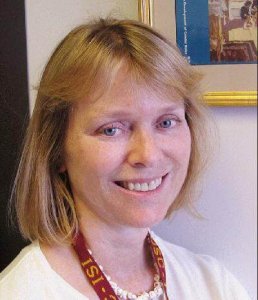
Carole Beal
USC’s Information Sciences Institute, long known for its research and development on the Internet and computer science, has embarked on a new challenge: K-12 Education.
Carole Beal, an educational psychologist who joined the Institute in late 2003, researches ways to improve the teaching process in K-12 classrooms using information technology.Herbert Schorr, executive director of ISI, which is part of the USC Viterbi School of Engineering, explained the background.
“Many parents are concerned that our K-12 educational system is falling short. We believe that information technology has a huge potential contribution to make to this problem. While sophisticated computer tools have been introduced with enormous success in other areas, in education their application is spotty and erratic, and fails to use the best technology.
“We hope that ISI can make the kind of contribution in this area that it has in communication, defense, robotics, language translation and computer hardware and software. I believe there is no higher priority, and I think Carole is the right person to guide our involvement.”
Beal directs ISI’s new Learning and Development Center, which focuses on fundamental research on learning and the use of technology to improve learning outcomes in K-12 classrooms. Beal’s work is closely tied to the ISI Center for Advanced Research in Technology for Education, which is nationally known for its work using artificial intelligence for educational ends.
Previously, ISI focused on training techniques for the military and health professions. “But the techniques have come of age and we believe the potential for K-12 education is exceptional,” says W. Lewis Johnson, the director of CARTE and Beal’s collaborator on many of the projects.
Four new projects provide individualized web-based tutoring in math and science for K-12 students, with a special focus on improving the representation of girls and students from groups that have traditionally been under-represented in science and technology. The projects include:
The Wayang Outpost project, supported by the National Science Foundation’s Research on Learning and Education (ROLE) program uses on-line assessments of high school students’ individual learning styles and attention to customize multimedia instruction in geometry. 
Another effort focuses on creating software to support the learning options that are more often preferred by female students, including on-line collaboration on math problem solving through chat and text messaging features.
A third project, “Dynamically Modifying The Learning Trajectories Of Novices With Pedagogical Agents,” study is funded by the Institute of Education Sciences (the new research office of the U. S. Department of Education). In collaboration with ISI’s CARTE and UCLA’s IMMEX Center, the project will use artificial intelligence to tailor high school chemistry material to students by continuously assessing skills and concentrating on areas that most need help.
Previous work by IMMEX-UCLA researcher Ron Stevens indicates that students all too often cling to inefficient ways to solve problems. The new collaboration with ISI will use AI agents as an efficient tool to help students shift to more effective problem solving strategies.
The fourth project (“AnimalWatch”) is also supported by the Institute of Education Sciences, and focuses on individualized web-based tutoring to support students at the difficult transition from arithmetic to algebra. Students work on math problems about endangered species, and take part in “virtual adventures” led by animated characters based on real scientists who use mathematics in their research.
In each project, the tutoring software is aligned with California curriculum standards for mathematics and sciences, and includes practice tests to help students prepare for annual state achievement tests.
The projects will collaborate with several local school districts, including Pasadena, and Placentia-Yorba Linda. “We also hope to work with USC’s Family of Schools,” said Beal, referring to a group of LA Unified School District schools located near USC’s University Park and Health Science campuses that have a close collaborative relation in many areas with USC.
“In fact, we are actively seeking California schools to partner with us on the new projects,” said Beal.
In addition to the projects on the use of technology to improve K-12 learning, Beal also investigates how the characteristics of human learning can be modeled to improve machine learning.
In collaboration with Senior Post-doctoral Fellow Clayton Morrison, Beal directs the DARPA funded “Human-like Learning” project that models the kind of non-verbal, spatial thinking humans do when they visualize problems and discover new solutions.
Beal came to ISI after 20 years at the University of Massachusetts at Amherst, where she was a professor of psychology. “Being at ISI is a great opportunity to work with world class computer science faculty and graduate students in creating technology to support K-12 educators, students, and families.” 
Published on June 1st, 2005
Last updated on August 9th, 2021













